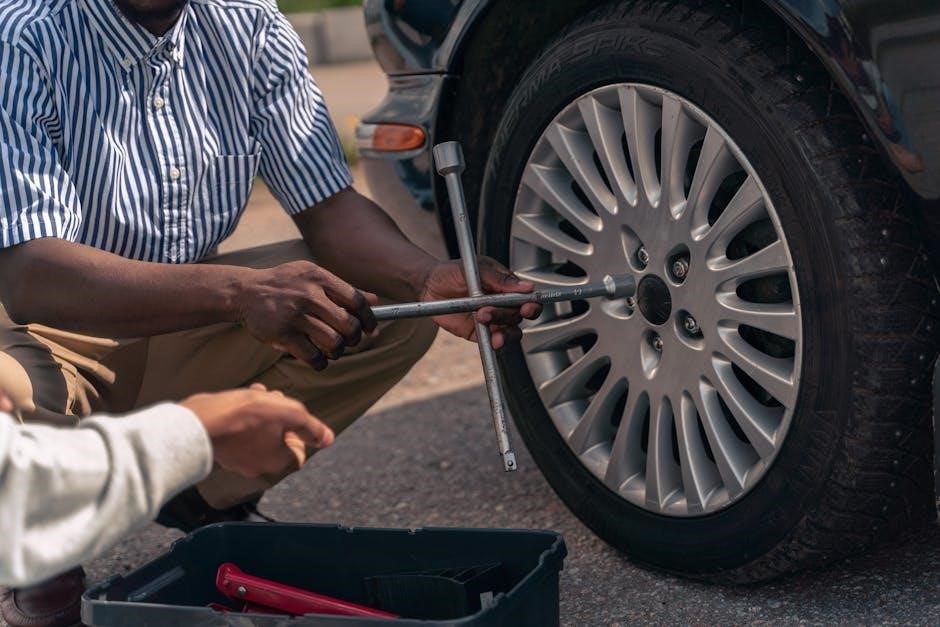
trampoline instruction manual
Trampoline safety is paramount to ensure enjoyable and injury-free experiences. Always read the manual to understand proper usage, weight limits, and essential precautions. Supervise children and avoid risky moves like somersaults. Regular inspections and maintenance are crucial to uphold safety standards and prevent accidents. Follow guidelines to maximize fun while minimizing risks.
1.1 Importance of Reading the Manual
Reading the trampoline manual is essential for safe and enjoyable use. It provides critical information on assembly, maintenance, and safety precautions. Understanding the instructions helps users avoid accidents, such as somersaults, which can cause serious injuries. The manual outlines weight limits, proper usage guidelines, and specific warnings to ensure the trampoline is used responsibly. Failing to read the manual can lead to improper assembly or ignoring safety tips, increasing the risk of harm. Always prioritize reviewing the manual before setup and use to guarantee a safe and fun experience for everyone involved.

1.2 General Safety Guidelines
Following general safety guidelines is crucial for a safe trampoline experience. Always supervise children and ensure only one person jumps at a time to prevent collisions. Avoid risky moves like somersaults, as they can lead to head injuries. Check the trampoline for damage before use and ensure all springs and padding are secure. Maintain a clear area around the trampoline to prevent falls onto hard surfaces. Never use the trampoline in bad weather or when wet. Adhere to weight limits and ensure the enclosure is properly installed. Regularly inspect the trampoline for wear and tear to maintain safety standards.
1.3 Weight Limits and User Restrictions
Adhering to weight limits and user restrictions is essential for safe trampoline use. Check the manual for maximum weight capacity, typically ranging between 200-300 lbs, depending on the model. Ensure no single user exceeds this limit to prevent structural damage or injury. Children under 6 years old should not use the trampoline without adult supervision. Avoid allowing multiple heavy users simultaneously, as this can strain the trampoline. Do not exceed the recommended weight limit, as it may void the warranty or lead to safety hazards. Always prioritize these guidelines to ensure safe and enjoyable use.

Assembly and Installation
Gather all tools and components before starting. Typically, a Phillips screwdriver and wrenches are needed. Two adults are recommended for safe assembly. Follow the manual step-by-step to avoid errors. Assembly time varies, but most trampolines take about 2 hours. Ensure all parts are securely tightened and double-check for stability. Refer to the manual for troubleshooting common issues during installation. Proper assembly ensures safety and longevity of the trampoline.
2.1 Tools and Equipment Needed
To assemble your trampoline, gather the necessary tools and equipment. A Phillips screwdriver and adjustable wrenches are typically provided or required. Additional tools like a rubber mallet and measuring tape may be useful. Ensure you have a clean, flat workspace and consider having a ladder for taller trampolines. Gloves and safety glasses are recommended for protection. Organize all components and hardware before starting. Refer to the manual for specific tool requirements, as some models may need additional equipment. Having everything ready ensures a smooth and efficient assembly process.
2.2 Unpacking and Organizing Components
Begin by carefully unpacking all components from the boxes to avoid damage. Lay out the frame, trampoline mat, springs, enclosure poles, and padding in a clear workspace. Check each item against the manual’s inventory list to ensure no parts are missing or damaged. Organize smaller hardware, such as screws and bolts, in labeled bags for easy access. Place heavier components, like the frame, on the ground to stabilize them during assembly. Clear the area of debris and ensure all tools are within reach. Proper organization prevents misplacement and ensures a smooth assembly process. Refer to the manual for part identification using labels or codes provided.
2.3 Step-by-Step Assembly Instructions
Begin by assembling the frame using the provided hardware, ensuring it is sturdy and level. Attach the trampoline mat securely to the frame with the springs, tightening them evenly. Next, install the enclosure net by threading the poles through the frame and securing them tightly. Use the included tools, such as the Phillips screwdriver and adjustable wrench, to fasten all connections. Always follow the manual’s sequence to avoid errors. Double-check that all parts are properly aligned and secured before allowing anyone to use the trampoline. Proper assembly ensures safety and optimal performance.
2.4 Installing the Trampoline Enclosure
Begin by attaching the enclosure net to the trampoline mat using the provided straps or hooks. Ensure the net is tightly secured to prevent sagging; Next, stand the enclosure poles upright and connect them to the trampoline frame using the included hardware. Make sure each pole is evenly spaced and firmly attached. Use the spring pull tool to tighten any loose connections. Finally, check the enclosure’s stability by gently tugging on the net and poles. Proper installation ensures the enclosure provides maximum safety and protection during use. Always refer to the manual for specific tightening sequences.
2.5 Troubleshooting Common Assembly Issues
If parts are missing or don’t fit, double-check the packaging and refer to the parts list in the manual. For loose connections, tighten all bolts and springs securely. If the mat sags, ensure springs are evenly attached. For tight spring rings, lubricate and stretch gently. If the net isn’t fitting, check pole alignment and retighten straps. If issues persist, consult the troubleshooting section or contact customer support. Patience and careful alignment are key to resolving assembly problems effectively. Always ensure stability before use to guarantee safety.

Usage Guidelines
Follow safe jumping practices, avoid somersaults, and ensure proper supervision, especially for children. Use the trampoline for its intended purpose and maintain a safe environment for all users.
3.1 Proper Techniques for Safe Jumping
Proper jumping techniques are essential for safe trampoline use. Always land with knees slightly bent to absorb impact and maintain balance. Avoid somersaults and flips, as they can lead to serious injuries. Ensure one jumper at a time to prevent collisions. Keep your center of gravity low and avoid jumping too close to the edges. Never attempt risky moves without proper training or supervision. Adults should guide children in correct jumping practices. Familiarize yourself with the trampoline’s weight limits and user restrictions. By following these guidelines, you can enjoy a safer and more enjoyable jumping experience for everyone involved.
3.2 Advanced Moves and Tricks
Advanced trampoline moves, like flips and somersaults, can be thrilling but dangerous if not performed correctly. Always prioritize safety by mastering basic jumping techniques first. Ensure proper supervision, especially for children, and use safety gear. Start with simpler moves, such as front flips, and gradually progress to more complex tricks. Never attempt moves beyond your skill level. Landing incorrectly can lead to injuries, so practice control and balance. Refer to your manual for guidance, and consider seeking professional instruction. Always ensure the trampoline is securely enclosed to minimize risks during advanced maneuvers.
3.3 Exercises for Cardiovascular Health
Trampoline exercises are an excellent way to enhance cardiovascular health while having fun. Simple routines like high knees, jumping jacks, and alternating foot jumps can boost heart rate and improve endurance. These low-impact movements are easy on joints, making them suitable for all fitness levels. For a more intense workout, incorporate burpees or jump squats. Regular trampoline use can also help reduce stress and improve coordination. Start with short sessions and gradually increase duration as fitness levels improve. Always maintain proper technique and supervision to ensure a safe and effective workout experience.

Maintenance and Care
Regular maintenance ensures trampoline longevity and safety. Inspect for wear, clean surfaces, and store properly during off-season. Addressing issues promptly prevents larger problems and ensures durability.
4.1 Cleaning the Trampoline Surface
Regular cleaning is essential for maintaining the trampoline’s condition. Use mild soap, water, and a soft brush to gently scrub the mat and padding. Avoid harsh chemicals or abrasive materials that may damage the surfaces. Rinse thoroughly with clean water and allow to air dry. For stubborn stains or dirt buildup, apply a mild detergent and let it sit before rinsing. Clean the enclosure net with a damp cloth to remove dirt and debris. Regular maintenance ensures a safe and hygienic environment for users. Always clean after extreme weather or heavy use to prevent damage.
4.2 Inspecting the Trampoline for Damage
Inspect the trampoline regularly for wear and tear. Check springs, padding, and mats for signs of damage or deterioration. Look for holes, tears, or fraying in the mat and enclosure net. Ensure all bolts and screws are tightened securely. Inspect the frame for rust or corrosion. Check the padding for proper coverage over springs and edges. Test the trampoline’s stability and ensure it is level. Replace any damaged or worn-out parts immediately to prevent accidents. Regular inspections help maintain safety and extend the lifespan of your trampoline. Always address issues promptly to ensure a safe and enjoyable experience for users.
4.3 Storing the Trampoline During Off-Season
Proper storage of your trampoline during the off-season is essential to protect it from damage. Disassemble the trampoline if possible, or securely tie the mat and enclosure net. Clean the surface thoroughly before storing. Store components in a dry, protected area away from direct sunlight and moisture. Use storage bags or covers to shield from dust and pests. Avoid leaving the trampoline exposed to harsh weather conditions. Check for any damage or wear before storing and address issues promptly. Regular maintenance ensures your trampoline remains in good condition for future use. Proper storage extends its lifespan and keeps it safe.

Safety Precautions and Warnings
Avoid somersaults and flips, as they can cause serious injury. Always supervise children and ensure the trampoline is placed on a soft, flat surface. Check for damage before use and adhere to weight limits. Never exceed the maximum user capacity, and ensure the enclosure net is securely attached. Regular inspections and proper maintenance are crucial to prevent accidents and ensure safe enjoyment of the trampoline.
5.1 Avoiding Somersaults and Flips
Avoid attempting somersaults or flips on the trampoline, as these can lead to serious head or neck injuries. Such moves are inherently risky and should never be attempted, especially by children. The trampoline is designed for safe, controlled jumping, not for performing advanced gymnastics. Always ensure users understand this precaution before allowing them to jump. Check the weight limit and ensure the enclosure is securely attached to prevent falls. Supervise children closely to enforce this rule. Adhering to these guidelines will help prevent accidents and ensure a safe, enjoyable experience for everyone. Remember, safety always comes first.
5.2 Supervising Children During Use
Always supervise children when they are using the trampoline to ensure their safety. Accidents can happen quickly, so an adult should be present at all times. Teach children to jump responsibly and avoid risky behaviors like somersaults or flips. Monitor the number of users to prevent overcrowding, as collisions can occur. Ensure kids understand and follow safety rules, such as no pushing or horseplay. Regularly inspect the trampoline for damage before use. Supervision is key to preventing injuries and ensuring a safe, enjoyable experience for children. Stay vigilant to protect them from potential hazards. Safety always comes first.
5.3 Ensuring Proper Trampoline Placement
Proper trampoline placement is essential for safety and functionality. Choose a flat, open area away from trees, fences, and power lines to minimize collision risks. Ensure the surface is level and firm to prevent tipping. Clear the surrounding area of obstacles like rocks or toys. Maintain a safe distance from structures to avoid accidents. Avoid placing the trampoline on uneven ground or slopes, as this can destabilize it. Always follow the manufacturer’s guidelines for placement and ensure the trampoline is securely anchored if necessary. Proper placement helps create a safer environment for users. Regularly inspect the area for hazards before use.

Troubleshooting Common Issues
Address common problems like a sagging mat, damaged springs, or a loose enclosure net. Consult the manual for step-by-step solutions to ensure your trampoline remains safe and functional.
6.1 Fixing a Sagging Trampoline Mat
A sagging trampoline mat can be fixed by ensuring it is tightly secured to the frame. Check the mat’s tightness and adjust the springs if necessary. Use the wrench provided to tighten loose springs or replace damaged ones. If the mat sags due to worn-out springs, replace them immediately. Ensure all spring clips are securely attached to both the mat and the frame. For severe sagging, consult the manual for guidance on adjusting or replacing the mat. Regular inspections can prevent this issue and maintain safety.
6.2 Replacing Damaged Springs or Pads
Inspect the trampoline regularly for damaged springs or pads, as they can compromise safety. To replace a spring, detach it using a wrench and secure the mat. Install a new spring, ensuring it is tightly fastened. For damaged pads, remove the old ones and clean the area; Attach new pads, aligning them properly with the frame. Ensure all springs and pads are securely fitted to maintain even tension and prevent accidents. Refer to the manual for specific instructions on replacing these components safely and effectively.
6.3 Adjusting the Enclosure Net
Ensure the enclosure net is securely attached to the trampoline frame for safety. Loosen the straps or hooks to adjust the net’s tightness. Pull the net firmly to eliminate sagging and align it evenly around the frame. Tighten the straps to secure the net in place. Check all sides to confirm proper alignment and stability; Inspect the net for any tears or wear, replacing it if necessary. Regular adjustments ensure the net remains effective in preventing falls and injuries. Always refer to the manual for specific guidance on your trampoline model.

Warranty and Manufacturer Information
Review the product warranty for coverage details and manufacturer liability. Contact customer support for inquiries or issues. Register your trampoline to validate the warranty and ensure proper support.
7.1 Understanding the Product Warranty
The product warranty covers manufacturing defects and ensures durability. Warranty duration varies by component, with frames and mats typically covered longer than springs and pads. Registration is often required to activate the warranty. Damage from misuse, improper assembly, or extreme weather is usually excluded. Review the manual for specific terms and conditions. Keep the warranty document safe for future reference. Understanding the warranty ensures you’re protected and informed about what’s covered and for how long. This helps maintain your trampoline’s performance and safety over time.
7.2 Contacting Customer Support
For assistance, visit the manufacturer’s website and navigate to the support section. Phone, email, and live chat options are typically available. Have your serial number ready for quicker service. Many companies provide FAQs and downloadable resources to address common issues. If you encounter assembly or maintenance problems, contact support for guidance. They can also help with warranty claims or replacement parts. Reaching out early ensures issues are resolved promptly, keeping your trampoline safe and functional. Customer support is your go-to resource for all trampoline-related inquiries.
7.3 Registering Your Trampoline
Registering your trampoline is essential for warranty validation and safety updates. Visit the manufacturer’s website and locate the registration section. Enter your product’s serial number, found in the manual or on the trampoline frame. Provide your contact information to complete the process. Registration ensures you receive important safety notices and recalls. It also grants access to exclusive customer support and personalized assistance. Keep your registration confirmation for future reference; This step is crucial for maintaining warranty coverage and staying informed about product updates.

Legal and Regulatory Compliance
Ensure your trampoline meets local safety regulations and manufacturer standards. Product liability may apply if instructions are not followed. Always adhere to legal requirements for safe usage.
8.1 Manufacturer Liability and Disclaimers
8.2 Adhering to Local Safety Regulations
Ensure compliance with local safety regulations when installing and using your trampoline. Weight limits and user restrictions must be followed to avoid legal issues. Supervision of children is often mandated by law. Proper placement of the trampoline, away from hazards, is crucial. Some areas may require specific safety certifications or inspections. Failure to comply can result in legal consequences. Always check local ordinances before installation and use. This ensures the trampoline meets all safety standards and regulations, promoting a safe and enjoyable experience for everyone. Stay informed to avoid penalties and potential risks.
8.3 Recalls and Safety Notices
Stay informed about recalls and safety notices related to your trampoline. Manufacturers often issue recalls due to potential safety hazards. For example, some trampolines have been recalled because they could forcefully hit users, leading to injuries. Check the manufacturer’s website for updates and download revised manuals if necessary. Register your trampoline to receive notifications about recalls or safety alerts. Always follow the latest guidelines to ensure safe usage. Ignoring recalls can lead to accidents, so staying proactive is essential for protecting users and maintaining compliance with safety standards.

Additional Resources
Access downloadable manuals, video tutorials, and join trampoline communities for support. These resources provide guidance on assembly, maintenance, and troubleshooting. Visit manufacturer websites for updated materials and tips to enhance your trampoline experience safely and effectively.
9.1 Downloading the Instruction Manual
Downloading the instruction manual is essential for proper trampoline assembly and safe usage. Visit the manufacturer’s website and search by brand or model number. Ensure the manual matches your specific product. Most manuals are available in PDF format for easy access. Review the contents, including parts lists, assembly steps, and safety guidelines. If you cannot find your manual, contact customer support for assistance. Some manufacturers also provide interactive or 3D assembly guides for clarity. Always read the manual thoroughly before starting assembly or using the trampoline to ensure a safe and enjoyable experience.
9.2 Accessing Video Installation Tutorials
Video installation tutorials are an excellent resource for assembling and setting up your trampoline. Many manufacturers provide step-by-step videos on their websites or through dedicated apps. These tutorials often include 3D animations and real-time demonstrations, making complex assembly steps easier to understand. To access them, visit the manufacturer’s official website or scan the QR code provided in the manual. Some brands also offer interactive guides that walk you through the process. Watching these videos can help reduce confusion and ensure your trampoline is assembled safely and correctly. Check for updates to ensure you have the latest version of the tutorial.
9.3 Joining Trampoline User Communities
Joining trampoline user communities can be a great way to connect with other enthusiasts, share experiences, and gain valuable tips. Many online forums and social media groups are dedicated to trampoline users, offering advice on assembly, maintenance, and safe usage. These communities often provide troubleshooting solutions and recommendations for accessories. Some manufacturers also host official forums or groups where you can interact with experts and other users. Participating in these communities can enhance your trampoline experience by providing support and resources. Always follow safety guidelines shared by experienced users to ensure a fun and safe experience for everyone.
Always prioritize safety, follow guidelines, and enjoy your trampoline responsibly. Proper usage and regular maintenance ensure years of fun and safe experiences for everyone.
10.1 Final Safety Reminders
Always prioritize safety when using your trampoline. Read the manual thoroughly and ensure all users understand the guidelines. Supervise children at all times and avoid risky moves like somersaults. Check weight limits and ensure the trampoline is placed on a flat, soft surface. Regularly inspect springs, pads, and nets for damage. Never exceed the maximum weight capacity or allow overcrowding. Keep the area around the trampoline clear of obstacles. Remember, safety is everyone’s responsibility. Enjoy your trampoline while maintaining these precautions for a fun and secure experience.
10.2 Enjoying Your Trampoline Experience
Your trampoline is a gateway to endless fun and fitness for the whole family. Embrace the joy of bouncing while improving balance, coordination, and cardiovascular health. Family bonding is effortless with shared laughter and playful competitions. Explore various exercises or tricks, starting with simple jumps and progressing to more advanced moves. For beginners, focus on proper techniques to build confidence. For experienced users, try creative routines or incorporate trampoline exercises into your workout. Remember to store the trampoline securely during off-seasons to preserve its quality. With proper care, your trampoline will remain a source of enjoyment for years to come.